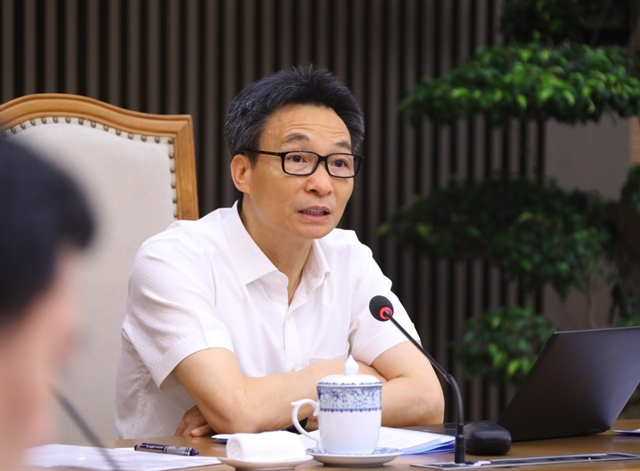 Politics & Law
Politics & Law


|
| Deputy Prime Minister Vũ Đức Đam chairs a meeting on the domestic pharmaceutical and herbal medicine industry on Wednesday morning in Hà Nội. — VNA/VNS Photo Văn Điệp |
HÀ NỘI — The domestic pharmaceutical and herbal medicine sector have been told to ensure sufficient supplies of quality medicines at reasonable prices.
This is the main goal of a programme to develop the domestic pharmaceutical and herbal medicine industry by 2030, which was issued by the Government in March 2021.
Deputy Prime Minister Vũ Đức Đam made the order at a meeting reviewing the implementation of the programme on Wednesday morning in Hà Nội.
Đam said: "Although it is a difficult task, we must do it."
He told the Ministry of Health to hold regular meetings and work with associations and pharmaceutical enterprises, as well as relevant agencies to handle specific issues and reach the goal.
He assigned the ministry to accelerate the renewal of drug circulation and registration certificates to overcome shortages of drugs and medical equipment.
The ministry has to urgently report on the mechanism of reference of innovator drugs in circulation and finish regulations on fees for the appraisal of dossiers for licensing, he said.
Đam also asked Việt Nam Social Security to urgently submit a plan to make additional payments for drugs and medical supplies that are covered by health insurance to medical facilities.
Strong growth
Vũ Tuấn Cường, director of the ministry’s Drug Administration of Việt Nam, said the Vietnamese pharmaceutical market is on a strong growth path, with total value rising from US$3.4 billion in 2015 to $6.92 billion in 2021.
Pharmaceutical spending per capita of Việt Nam last year reached $73 and the number is estimated to be $75 this year, he said.
The average growth rate of the pharmaceutical sector is 10-12 per cent per year. Domestic drugs account for 46 per cent of the total drugs for treatment, he said.
Currently, the country now has 228 pharmaceutical factories meeting World Health Organisation - Good Manufacturing Practices (WHO-GMP) standards, he said.
According to reports of 11 domestic enterprises, the total investment capital in Good Manufacturing Practices – European Union (GMP-EU) and Pharmaceutical Inspection Co-operation Scheme - Good Manufacturing Practices (PIC/S-GMP) production lines in the last five years reached about VNĐ12 trillion ($507 million).
About 14.3 per cent of domestic pharmaceutical factories are fully automated while 68 per cent have automatic equipment, mainly focusing on the production of generic drugs, he said.
Cường said that Việt Nam's pharmaceutical sector has many opportunities for development and the sector is ready to receive investment from modern pharmaceutical industries in line with the sector’s direction and goals.
Along with that, all current regulations, from general to specialised regulations, have created favourable conditions for the development of the pharmaceutical sector; and made incentives and investment attraction for production, especially the production of specialised drugs, high-tech drugs, innovator drugs, biological drugs, biological vaccines and medicinal materials, he said.
Shortcomings, recommendations
However, production facilities mainly focus on investing in the production of common generic drugs, not focusing on research and production of high-tech drugs, new drugs, innovator drugs and specialised drugs, he said.
The main reason is that the research of these drugs often require large investment, time, and high-quality human resources while there are currently no policies and mechanisms to promote the research and production of these drugs, he said.
Statistics show that innovator drugs account for only 3 per cent of the total drugs, but account for 22 per cent of the total value, he said.
Moreover, high-tech drugs, new drugs and specialised drugs used at medical examination and treatment establishments often make up a large proportion of the drug value, although the number of uses is low, he said.
The price negotiation and centralised bidding for innovator drugs is still slow for many reasons, including the lack of reference information and price comparison, he said.
The policy on drug price management and orientation on the use of generic drugs has caused limitations in the transfer of technology for the production of new and innovator drugs, he said.
Regulations on protection of intellectual property rights and anti-counterfeit goods also cause concern for domestic and foreign investors and businesses, he said.
He suggested the pharmaceutical sector focus on attracting investment in pharmaceutical granulation technology and improving product quality; raw material production; building centres for research on vaccines, biological products and technology transfer of multi-price vaccines; develop domestic sources of medicinal herbs as well as improve the capacity of pharmaceutical research and testing.
Đinh Xuân Huấn, General Director of Việt Nam Pharmaceutical Corporation (VINAPHARM), said that pharmaceutical enterprises need financial difficulties solved, because they have not received payment from medical facilities that bought drugs.
Besides, the investment mechanism for high-tech drug production should be flexible to combine the production of other conventional drugs, he said.
Trần Thị Thư, Vice President of the Việt Nam Pharmaceutical Companies Association, said there should be regular meetings between managerial agencies and pharmaceutical enterprises to handle problems arising. — VNS




